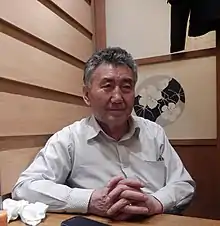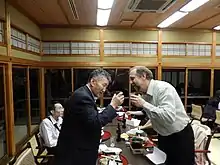Wushour Silamu
Wushour Silamu or Wushour Slamu (Uighur: ھۇشۇر ئىسلام, romanized: Hushur Islam, lit. 'Ⱨuxur Islam'; simplified Chinese: 吾守尔・斯拉木; traditional Chinese: 吾守爾・斯拉木; pinyin: Wúshǒu'ěr Sīlāmù; born 15 October 1941), is a Chinese computer scientist of Uyghur nationality.[1] He is a professor at Xinjiang University in Ürümqi and specializes in multilingual computing, especially with reference to the Uyghur language and other minority languages of Xinjiang.
Wushour Silamu 吾守尔・斯拉木 | |
|---|---|
 Wushour Silamau in 2015 | |
| Born | October 15, 1941 |
| Citizenship | China |
| Alma mater | Xinjiang University |
| Scientific career | |
| Fields | Computer science |
| Institutions | Xinjiang University |
Biography
Wushour was born in Yining, Xinjiang in 1941 and graduated from the Department of Physics at Xinjiang University in June 1964.[1] He has held positions at Xinjiang University as vice-chair of the Department of Electronic Engineering and chair of the Department of Computing and is currently director of the Xinjiang Multilingual Information Processing Key Laboratory (Chinese: 新疆多语种信息处理重点实验室; pinyin: Xīnjiāng Duōyǔchóng Xìnxī Chǔlǐ Zhòngdiǎn Shíyànshì).

Wushour is an expert member of the WG2 working group of the ISO/IEC JTC 1/SC 2 subcommittee for coded character sets and has attended international meetings of the working group between 1994 and 2015.[2] He has authored a number of proposals to encode characters required for Uyghur Arabic alphabet in the Unicode Standard, as well as a proposal to encode the Old Turkic script.[3]
In 2011, Wushour was elected as the first Uyghur academician of the Chinese Academy of Engineering (CAE).[1]
Wushour was elected as a Xinjiang delegate to the 12th National People's Congress which was convened from 2013 to 2018.[1]
References
- "吾守尔·斯拉木" [Wushour Silamu] (in Chinese). Chinese Academy of Engineering. Retrieved 30 September 2018.
- "WG2 attendance log". Retrieved 30 September 2018.
- "Proposal for encoding the Old Turkic script in the SMP of the UCS" (PDF). 25 January 2008.
External links
| Wikimedia Commons has media related to Wushour Silamu. |